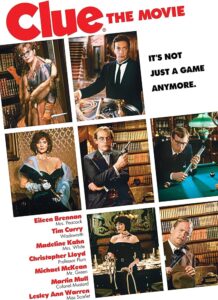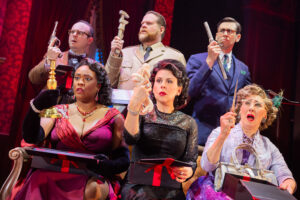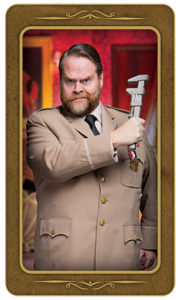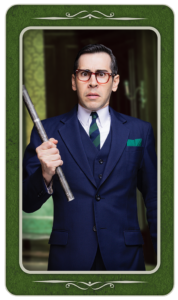Clue
I have to admit from the start that I’m biased in favor of this play: it’s a faithful and spirited adaptation of the 1985 cult classic Clue. I grew up watching the black comedy on DVD and was excited when I saw the play was coming to TPAC. The film was made when producer Debra Hill wanted to make a comedy-mystery based off the board game Clue, and acquired the rights from the Parker Brothers. It took her several years to find a studio, director, and screenwriter. Jonathan Lynn (who directed My Cousin Vinny), a British playwright and director, ended up writing and directing the film. In 2017 he adapted the screenplay for the stage, and now it’s on a national tour.

The plot of Clue is ridiculous and delightful. It’s the 1950’s, at the height of the McCarthy hearings. Six guests arrive at an old mansion and are greeted by Wadsworth, the butler. They go by pseudonyms (Colonel Mustard, Miss Scarlet, etc.) and as they speak with each other it is clear that they don’t know who their host Mr. Boddy is. As they wait for him to arrive, they all attempt to discover more about each other without giving away anything about themselves. Finally Wadsworth explains that they are all blackmail victims, and now is their chance to throw off Mr. Boddy’s oppression by refusing to pay him anymore and turning him in when the police arrive in an hour. But when Mr. Boddy arrives he gives each guest a gift: the classic weapons from the board game. He tells them that if they kill Wadsworth for him, then he’ll stop blackmailing them. Then he turns off the light. When the light is turned back on there is a dead body, but it isn’t Wadsworth’s. This proves to be only the first murder of the evening and the group scrambles to discover what’s going on while their time slowly runs out.
The entire play takes place at Boddy Manor. The set is excellent, an archetypical creepy mansion. The main stage is a large entry hall, with double front doors at the center. Along the sides of the hall are doors to adjoining rooms. These rooms can be simple doorways or they can pivot open to reveal a room: the library, kitchen, or lounge. Much of the film involves running around the mansion from murder to murder, and exploring the building in pairs. I was curious how they would make this work on stage. They do it cleverly: with dramatic hurried music they comically run in place as the set and lighting change. Farcical paired choreography establishes their search of the building.

The original film was released in theaters with three separate endings, hypothetically meaning people would see the film three different times (this gimmick didn’t seem to succeed). When Clue was released on home video, the three endings were all included sequentially, with two being shown as possibilities but the third ending being the real one. The play includes multiple different endings and switches between them in a goofy, “rewound” manner, until the final ending. I won’t give any spoilers, but I will say that the final line of the play is identical to the final line of the film.
Clue is roughly 90 minutes with no intermission, almost the same length as the film, and the perfect length for a comedy. The humor and manic speed of witty dialogue are maintained in the play, made more impressive by each actor’s memory and comic timing. This play is an ensemble endeavor with jokes and plot points constantly bouncing from character to character.

Everyone is vibrant and ridiculous in their own way. One difficulty in an adaptation is to avoid doing an impression of the original actor without losing the beloved character’s identity. The cast does this well, maintaining the personalities while bringing something of their own. I attended the show Tuesday night, when understudy James Taylor Odom appeared as Wadsworth. He speaks with a similar accent and breathlessness as Tim Curry in the film, but I think breathlessness cannot be avoided in his role: Wadsworth has more lines than anyone else and each of his rapid lines matter, moving the plot and the dialogue of everyone else. Odom nails the role.

The character with the most new lines is Colonel Mustard. He’s a complete idiot and constantly misunderstands people, making delightful puns. If there’s something I love in a comedy, it’s puns and idiots, and John Treacy Egan plays him fantastically. An unexpected new facet is in Mr. Green, played by John Shartzer, who surprised us all with his hilarious and unexpected athleticism.
Jen Caprio’s costumes are great, fitting the stereotypes of the characters and helping accentuate their mannerisms. Each person looks so different that it helps the audience keep track of the characters. John Morris’s dramatic strings, harpsichord, and radio-drama organ music of the film is retained, altered slightly to become the play’s incidental music. The music is so good and ridiculous and threatening all at once, making it perfect for this farce.

Clue has far fewer innuendos than the film, making it a good choice for parents with older kids who can enjoy witty dialogue and dark humor. It also was over by 9:00, making it convenient for anyone who has a drive ahead of them. While I’m far too familiar with the film to have been surprised more than a few times during the play, the audience roared with laughter at every joke. I don’t know if they had also seen the movie, but whether you have or haven’t, you’re guaranteed a good time.
Clue will be at TPAC’s Jackson Hall through September 15. For tickets and more information see Clue | TPAC®, and for more information about the tour see Clue – A New Comedy.





[…] to ensure satisfaction while offering a fresh experience. For instance, adaptations like “Clue” engage audiences through humor and mystery, playing on the nostalgia of those familiar with […]